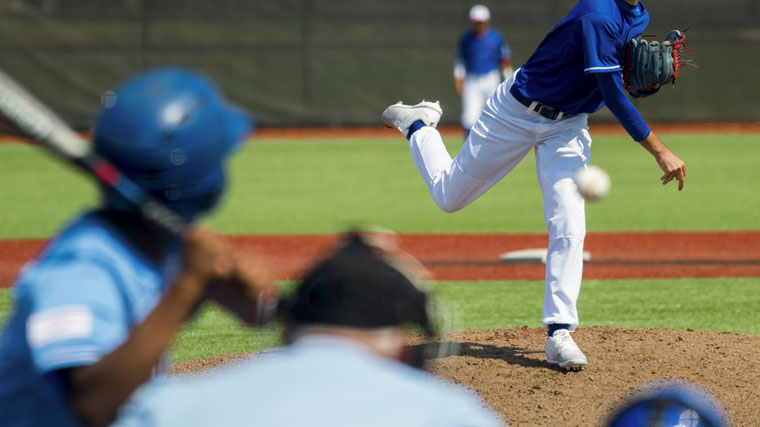Play Ball! Overuse Injuries Common Among Baseball Players

Answer a few questions and we'll provide you with a list of primary care providers that best fit your needs.
From Little League to high school athletes, kids across the country will be taking to the field each spring to play America’s pastime, baseball.
Before you send your kids out to practice and play, it’s good to keep in mind some of the possible injuries baseball players can have — especially injuries related to overuse.
Overuse injuries are extremely common in baseball, due to the repetitive nature of the game. Especially in throwers, there are a lot of overuse injuries to the shoulder and the elbow.
Common Overuse Injuries
Some of the most common injuries seen in baseball players include labral tears, “dead arm,” muscle strains, thrower’s elbow, and UCL elbow strains. Some of the signs you can watch for in each of these injuries:
- Muscle strain: Muscle strains happen when athletes have partial tears or stretch injuries to their muscles. They are classified as Grade 1, 2 or 3, depending on how severe the injury is. Grade 1 is just a stretching injury of the muscle. Grade 3 is a complete tear, which is thankfully less common. Baseball’s repetitive nature puts high stress on certain muscle groups, placing these muscle groups at higher risk for this type of injury.
- Labral tear: This injury is a disruption or stretching to the structure surrounding the socket part of the shoulder, known as the glenoid. The labrum gives stability to the shoulder, so when it’s disrupted or torn, it makes the shoulder potentially unstable.
- “Dead arm”: This is a general/non-specific diagnosis that can be caused by multiple injuries or multiple issues in your shoulder. Most often, “dead arm” happens in throwing athletes, causing them to have decreased control, accuracy, and velocity. Some pitchers who have “dead arm” don’t know they have it, they just can’t throw as fast or accurately as they used to.
- Thrower’s elbow: Also known as medial epicondylitis, this syndrome causes pain on the inside part of a thrower’s elbow. It creates enough discomfort that the thrower not only notices the pain, but it also affects their throwing motion. Though it’s usually caused by overuse or sudden increased use, it can also be caused by incorrect throwing technique.
- UCL elbow strain: This strain is similar to thrower’s elbow but is specific to the ulnar collateral ligament (UCL), which is on the inside part of the elbow. A UCL elbow strain is caused when the ligament is stretched or partially torn. Though this usually happens over time, it also can occur during a traumatic injury. Throwers will notice pain on the inside of their elbow, and the injury can lead to decreased velocity and poor ball control.
Preventing Overuse Injuries
Athletes can take steps to prevent overuse injuries, during both practices and games.
Warming up before a game or practice session is essential. Stretching is very important, and some athletes even like to apply ice to the shoulder and perform other stretching activities before competing in the game. Likewise, a cool down is very important after the game to allow the muscles to recover.
Resting after a game is necessary, too. Giving players — especially younger ones — several days of rest after a game in which they throw 50 or more pitches is important to help avoid injuries.
According to the American Journal of Sports Medicine, young pitchers put themselves at risk of injury if they:
- Throw too many innings over the course of a year. Youths who pitched more than 100 innings in a year were 3.5 times more likely to have an injury.
- Play for multiple teams at the same time
- Continue throwing despite arm fatigue. Pitchers who did so were 36 times more likely to suffer an injury
- Play more than 8 months in a year
- Participate in showcases
Cross-training can also be a key part of helping players keep from getting injured.
Some studies have shown that cross-training and varying the activity that an athlete, especially a young athlete, performs is very helpful to overall efficiency and overall excellence in a certain type of sport. Generally speaking, athletes should not play competitive baseball year-round. They need variability in their activity to perform at their top level during baseball season.
Tracking and limiting pitch counts in baseball players is also an important part of keeping these athletes healthy.
The American Sports Medicine Institute and Little League baseball recommends these appropriate maximum pitch counts by age:
- 7 and 8 year olds: 50 pitches
- 9 and 10 year olds: 75 pitches
- 11 and 12 year olds: 85 pitches
- 13 to 16 year olds: 95 pitches
- 17 and 18 year olds: 105 pitches
Because their bones and muscles are still growing, younger athletes and throwers should be throwing less than our older athletes. Having the maximum pitch counts is important because pitching beyond those numbers leads to overuse injuries, which can limit the amount of time the athlete actually is able to participate in a season. Permanent or semi-permanent damage to the elbow or shoulder can occur if pitch counts are not followed appropriately.
Answer a few questions and we'll provide you with a list of primary care providers that best fit your needs.
Sources: American Journal of Sports Medicine




